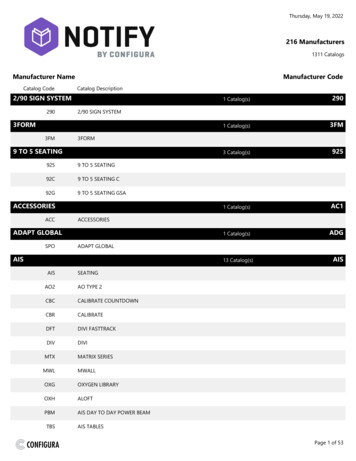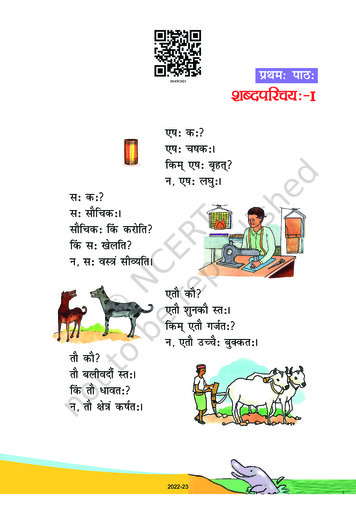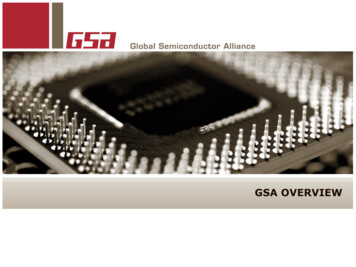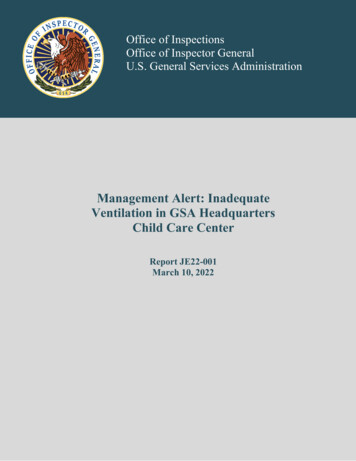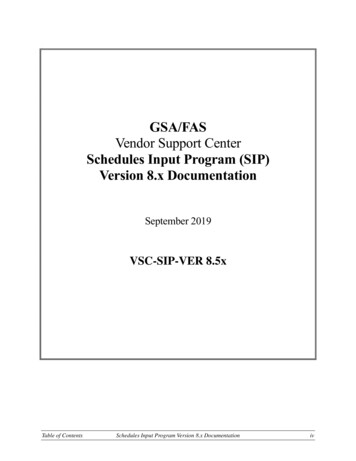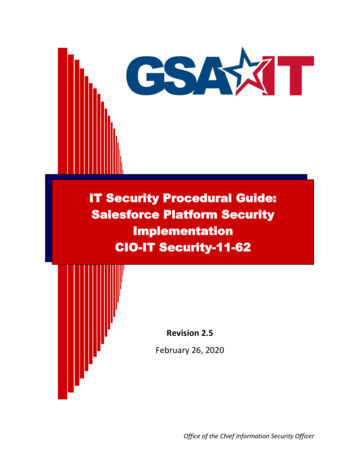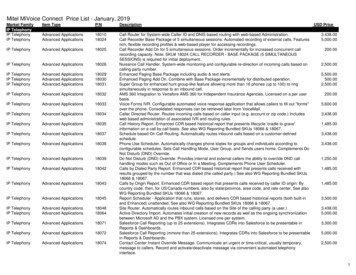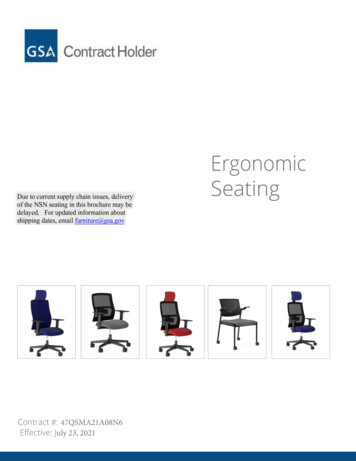
Transcription
U.S. General Services AdministrationFederal Acquisition ServiceGSA TRANSITION COORDINATION CENTERTRANSITION HANDBOOKNETWORX, WITS 3, AND GSA REGIONAL LOCALSERVICES TO ENTERPRISE INFRASTRUCTURESOLUTIONS (EIS) CONTRACTSVersion 2.0June 8, 2016DTID #: TCC-ASC-342-02-20160506-2.0PREPARED FORTransition Coordination CenterGeneral Services AdministrationFederal Acquisition Service1800 F Street NWWashington, DC 20405Contract Number: GS00Q12NSD0002Order Number: GSQ0016NS3001
TABLE OF CONTENTS1 PURPOSE12 BACKGROUND13 SUCCESSFUL TRANSITION3.1 Involvement of the Agency’s highest levels and key functional areas3.2 Agency Transition Plan3.3 Early and effective support from GSA to Agencies3.4 Phased, orderly approach3.5 Transparency and meaningful reporting1222224 TRANSITION OVERVIEW4.1 Transition Approach4.2 Transition Sequence of events3345 Roles and Responsibilities5.1 Agency Transition Sponsor5.2 Agency Transition Managers5.3 Ordering Contracting Officers5.4 GSA Regional Services566776 Lessons Learned from Previous Transitions87 Transition Planning7.1 Identify Key Agency Personnel7.2 Confirm Inventory7.3 Define Requirements and Order Placement Process7.4 Arrange for GSA Assistance7.4.1 GSA-Assisted Transition7.4.2 Transition Assistance7.4.3 GSA TCC Training Plan89910111111128 Transition Management and Implementation8.1 Award Task Orders8.2 Ordering Process8.3 Transition Tracking and Reporting8.4 Stakeholder Communications for Transition8.4.1 Infrastructure Advisory Group (IAG)8.4.2 Help Desk8.4.3 EIS Transition Websites8.5 Disconnects131313131414141515
9 Summary15Appendix A – Acronym List16Appendix B – Agency Transition Plan Outline171 Project Scope and Charter172 Leads for Integrated Transition Team2.1 Agency Transition Sponsor2.2 Lead Transition Manager2.3 Transition Ordering Contracting Officer (TOCO)2.4 Escalation Path to Agency Transition Sponsor17171717183 Support Organization3.1 Integrated Transition Team Members3.2 Support Contractors3.3 AHC Structure181818184 Strategy4.1 Agency priorities and objectives during transition4.2 FO decisions4.3 Schedule181818195 Inventory Analysis5.1 Summary by service type, quantities, locations5.2 Equipment condition5.3 Confirmation status191919196 Mission Analysis6.1 Constraints6.2 Risks6.3 Jeopardies19191919
This document is hereby authorized for release by the General ServicesAdministration./ Amando E. Gavino, Jr. /Amando E Gavino, Jr/SIGNATURE AUTHORIZED/ June 17, 2016DOCUMENT CHANGE ginal IssueUpdatedUpdated – incorporated GSA feedback from 4/15emailUpdated – incorporated GSA feedback from 5/03meetingEdits for revised submissionDRAFT Routed for NSP and AcquisitionOperations reviewFinal version routed to Amando for authorizationto releasePrepared byDebbie HrenJoe HesterChuck BrockChuck BrockTatia SheptockDebbie HrenCharles Martin
TRANSITION HANDBOOK1 PURPOSEThe General Services Administration (GSA) developed this handbook for agencies andother stakeholders to facilitate a successful, timely, and orderly transition of services fromthe expiring Networx, Washington Interagency Telecommunications Systems (WITS) 3,and GSA Regional local services contracts to the Enterprise Infrastructure Solutions (EIS)contracts.This document advocates the importance of coordination and cooperation amongtransition stakeholders. This is achieved by (1) defining a standardized approach for allagencies across the government, (2) recommending a sequence of transition events, (3)describing transition roles and responsibilities, and (4) providing guidance on transitionprocesses and procedures from the agencies’ perspective. This handbook provides aframework for agencies to manage a successful transition by describing the essentialactivities to prepare for, execute, and track transition. It includes an overview of activitiesagencies perform to order services under the new contracts and complete theirtransitions.2 BACKGROUNDGSA’s Network Services 2020 (NS2020) represents a portfolio of contracts that providethe flexibility and agility to support agency migrations to future technologies whileadhering to the high-level objectives laid out in the Information Technology (IT) ReformPlan and Digital Government Strategy. NS2020 enables interoperability and furthers themigration from legacy technologies to a converged Internet Protocol (IP) environment withcommon, core security standards through an expansive array of moderntelecommunications and IT service offerings. As part of the “Infrastructure Solutions”component of NS2020, the EIS contracts provide high-quality telecommunications andnetwork services and solutions that meet or exceed agency requirements, conform togovernment policies and standards, and offer competitive pricing. EIS providescontinuous competition to satisfy specific networking projects, emerging requirements,technology refreshment, and access to innovative solutions. The combination of moreservices, greater competition, and improved performance provides significant incentiveto transition to EIS.3 SUCCESSFUL TRANSITIONIn addition to the benefits of transitioning to EIS, stakeholders must be mindful of thecritical schedule for completing transition. GSA will help agencies through transition;however, it is up to the agencies to execute transition before the Networx, WITS 3, andGSA Regional local services contracts expire, either by competitively orderingreplacement services on EIS or by justifying a sole-source action to move existingservices from the current provider’s Networx, WITS 3, and GSA Regional local servicescontracts to their EIS contract, if that is available. The Networx, WITS 3, and GSARegional local services contracts will expire in May of 2020. Agencies must beginplanning now and have detailed plans, current inventories, resources, and processes inDTID #: TCC-ASC-342-02-20160506-2.01v2.0 June 8, 2016
TRANSITION HANDBOOKplace to execute transition as soon as the EIS contracts are awarded. Agencies mustexpect to complete transition by May 2020 to maximize the savings from EIS prices andavoid the disruption caused by the expiration of the existing contracts. Therefore, manyrelated actions, such as developing task order solicitations, should be completed prior tothe award of the EIS contracts.In concert with agency customers, contractors, and oversight organizations, GSA willimplement a transition strategy that capitalizes on lessons learned from previoustransitions to effect a successful transition. The key elements of this strategy follow:3.1 Involvement of the Agency’s highest levels and key functionalareasThe engagement of executive management is critical to secure and focus the resourcesacross the agency to plan and implement the transition, to track progress, and to respondto risks. GSA will ask each agency to identify, by name, an executive sponsor for thetransition. Another fundamental requirement is early assignment of a Lead TransitionManager (LTM) and a Transition Ordering Contracting Officer (TOCO) that understandsthe Federal Acquisition Regulation (FAR) and agency’s policies for selecting a contractorand has a repertoire of workable approaches to meet the agency’s transitionrequirements.3.2Agency Transition PlanAgencies must develop a transition plan and provide it to GSA. GSA will track this as acritical milestone to be completed by October 2016, with updates and additional detail asneeded throughout transition.3.3 Early and effective support from GSA to AgenciesFrom the earliest agency engagements, GSA will provide tailored support to each agencyappropriate to its transition approach, especially for the contractor selection, or “fairopportunity” (FO) process (see FAR Subpart 16.505). GSA will work with the existingNetworx, WITS 3, and GSA Regional local service contractors to conduct the initialvalidation of inventory. GSA will provide training and a user’s guide for ordering on theEIS contracts.3.4 Phased, orderly approachGSA will coordinate with agencies and contractors to develop a recommended sequenceof transition orders to achieve early progress, level resource demands, and minimizebacklogs. GSA will work with all stakeholders to guide transition through this sequence.3.5 Transparency and meaningful reportingGSA will define and openly track major milestones and report agencies’ progress to OMB.Measures of transition progress will be developed in collaboration with agencies andDTID #: TCC-ASC-342-02-20160506-2.02v2.0 June 8, 2016
TRANSITION HANDBOOKcontractors and will be representative of business volume and the complexity of servicesbeing moved.4 TRANSITION OVERVIEWFor the purposes of this handbook, transition is defined as the movement of services fromthe expiring Networx, WITS 3, and GSA Regional local service contracts to EIS andcontinues until all services have been disconnected. Transition planning, execution, andmanagement activities are critical to a successful transition to EIS and requireparticipation by all relevant stakeholders. Agencies using Networx, WITS 3, and GSARegional local service contracts have the primary responsibility for completing transitionsuccessfully; accordingly, they should have an executive level sponsor for the agency’stransition.GSA, as the owner of the contracts and Program Management Office (PMO), supportsthe agencies by managing the contractors, and the program’s Transition CoordinationCenter (TCC) provides Government-wide transition planning, execution, progresstracking, and reporting. GSA established the TCC, which is staffed by both GSA andcontractor personnel, to assist and support Agencies and the GSA Regions with themovement of services from the expiring contracts to EIS. The TCC’s customers are bothinternal and external to GSA and include the GSA Regions, agencies, existingcontractors, EIS contractors, and oversight organizations such as the Office ofManagement and Budget (OMB) and Government Accountability Office (GAO).4.1 Transition ApproachIn its report GAO-06-476, TELECOMMUNICATIONS: Full Adoption of Sound TransitionPlanning Practices by GSA and Selected Agencies Could Improve Planning Efforts, June2006, the GAO identified the following best practices for conducting effective transitionplanning:1. Establish an accurate telecommunications inventory and an inventorymaintenance process2. Perform a strategic analysis of telecommunications requirements and use thisto shape the agency’s management approach and guide efforts whenidentifying resources and developing a transition plan3. Establish a structured management approach that includes a dedicatedtransition management team that will use clear lines of communications inaddition to key management processes, such as project management,configuration management, and change management4. Identify the funding and human capital resources that the transition effort willrequire5. Develop a transition plan that includes transition objectives, measures ofsuccess, and risk assessment, and a detailed timeline.In a subsequent audit of transition practices, GAO reported in GAO-14-63,DTID #: TCC-ASC-342-02-20160506-2.03v2.0 June 8, 2016
TRANSITION HANDBOOKTELECOMMUNICATIONS: GSA Needs to Share and Prioritize Lessons Learned toAvoid Future Transition Delays, December 2013, that each agency should develop atransition project management plan that includes “a time line of all activities that need tobe completed, taking into account priorities relative to the agency’s mission criticalsystems, contingency plans, and identified risks.” Agencies’ transition teams, includingproject managers, telecommunications specialists, and contracting officers, shoulddevelop the Agency Transition Plan (ATP) and coordinate with executive leadership, suchas the Chief Information Officer (CIO) as executive sponsor and other executives such asthe Chief Financial Officer, Chief Acquisition Officer, and Chief Human Resources Officeras appropriate. An outline to the ATP is included in Appendix B to facilitate this process.The executive sponsor must then deliver the ATP to GSA’s Assistant Commissioner ofFederal Acquisition Service (FAS)/Integrated Technology Services (ITS) by October2016. The standardized format and required delivery ensure all stakeholders—includingand especially the contractors--are aware of the agency’s plan and can better supportmeeting the agency’s objectives in conjunction with the overall objectives of the transitionprogram.4.2 Transition Sequence of eventsTo keep the focus on timely transition, GSA has identified critical milestones for agenciesto meet. These, along with other common steps in transition, comprise the followingactivities necessary for agencies to successfully complete transition: PRIOR TO AWARD OF EIS CONTRACTSo Develop funding requirements and coordinate with agency budgetsubmissions for FY 2017 – 2020. Task orders on EIS will require fundingat the time of issue; therefore, it is critical that agencies budget forinstallation charges for services on EIS starting in FY17. GSA can helpestimate those charges and advise on strategies to minimize the cost to theagencies. For additional information, contact your Technology ServiceManager (TSM).o Identify the Agency Transition Sponsoro Understand EIS Services, management and operations requirements, andpricing structure; become familiar with the EIS Request for Proposal (RFP)(see gsa.gov/eis) and subscribe to Interact at https://interact.gsa.gov/eis forreal-time notifications of updateso Appoint both a Lead Transition Manager (LTM) and Transition OrderingContracting Officer (TOCO) and identify transition organization (see Section5, Roles and Responsibilities)o Confirm existing Networx, WITS 3, and GSA Regional local serviceinventories to ensure they are accurate and current by October 2016; forinstructions go to gsa.gov/eiso Evaluate current technical solutions and develop transition planning fortarget technical solutions, including upgrades, transformations, retirement,or other changeso Develop Agency Transition Plan (ATP) by October 2016DTID #: TCC-ASC-342-02-20160506-2.04v2.0 June 8, 2016
TRANSITION HANDBOOKo Estimate human resource requirements and coordinate with agency staffingand training plans for FY 2016-2020o Initiate solicitations for the FO process to select EIS contractors, such asRFPs for complex requirements and RFQs for simple requirementso Execute an Interagency Agreement (IA) with GSA for assistance, asapplicable. AFTER AWARD OF EIS CONTRACTSo Attend training and receive a Delegation of Procurement Authority (DPA)from GSA to agency Ordering Contracting Officers (OCOs)o Conduct fair opportunity selection of contractor(s) and award fully-fundedTask Orders (TOs)o Update ATP as appropriate and share with GSAo Order services for transition on EISo Order disconnects on Networx, WITS 3, and GSA Regional local servicecontracts.Figure 1 below, Transition Sequence of Events, depicts a sequence of events anddeadlines for agencies to successfully accomplish transition activities. Note that in orderto expedite the FO process, agencies are advised to begin preparing their solicitations inadvance of EIS award and expect to release those solicitations as soon as possible afteraward.Figure 1: Transition Sequence of Events5 Roles and ResponsibilitiesThis section describes the roles and responsibilities of key personnel for transition to EIS.DTID #: TCC-ASC-342-02-20160506-2.05v2.0 June 8, 2016
TRANSITION HANDBOOK5.1 Agency Transition SponsorEach agency should have an executive level manager that sponsors the agency’stransition project; the lessons learned in previous transitions highlight the need for thissupport. The sponsor likely would be the CIO or executive of the organization to whichthe transition manager and team report or that otherwise has influence to secure thefinancial and human resources for the transition. The sponsor serves as a spokespersonto senior agency leadership, is the primary interface and partner to GSA executives, andis the agency’s representative accountable to oversight organizations, such as OMB.Important activities for the Agency Transition Sponsor include approving the agency’sATP and serving as an escalation path. For department level agencies, the sponsorshould represent all components within the department.5.2 Agency Transition ManagersEach agency should have a Lead Transition Manager (LTM) and may also designateother supporting transition managers (TMs). A TM is a Government employee (orappointed contractor) who leads the planning, management, and implementation of theagency’s transition of services from Networx, WITS 3, and GSA Regional local servicecontracts to EIS. The LTM develops the ATP; acts as the central point of contact to GSA’sTCC; executes, tracks, and reports transition activities; and escalates issues to GSA asappropriate. In GAO-14-63, GAO reported that “weaknesses in agencies’ projectplanning also contributed to the delays” in the transition to Networx. Therefore, the LTMmust have strong project management, communications, and interpersonal skills and bea recognized leader within the agency.The process for establishing a transition team starts with the Agency Transition Sponsordesignating the LTM for the agency. The sponsor communicates this designation to GSA.The LTM may then designate other supporting TMs for the agency.Agency TMs: Engage agency staff to address requirementsProvide overall project management of the agency’s transition to EIS, includingmeeting milestone deadlines and managing project risksPlan and prepare agency-specific transition strategies and the ATP along withmore detailed plans as neededExecute, track, and report on activities of the overall transition to ensure that theAgency Transition Sponsor, agency management, GSA, and oversight groups arewell aware of the status and any jeopardies to meeting the scheduleIdentify the Agency-Bureau (AB) codes that fall under the authority of the agency,any hierarchical organization of those codes, and the mapping of AgencyHierarchy Codes (AHCs) to AB codesConfirm the agency’s inventory of services to transitionEnsure transition orders are placed in a timely fashion; prioritize orders for servicesDTID #: TCC-ASC-342-02-20160506-2.06v2.0 June 8, 2016
TRANSITION HANDBOOK that have lengthy or complex installationsServe as the interface to the GSA TCCCoordinate training by GSA for the agency’s transition team and support personnelEscalate issues to GSA, the EIS contractors, or agency management and AgencyTransition Sponsor as appropriateSubmit or validate and forward requests for agency personnel to access transitionsystems in order to centrally control who has what authorities within each system.5.3 Ordering Contracting OfficersThe agency’s Ordering Contracting Officers (OCOs), or other officials who have authorityto obligate the agency’s funds, are critical to the success of transition and, therefore, mustbe part of the agency’s transition team from the outset. The TOCO is the agency’sacquisition lead for facilitating the OCOs use of the EIS contracts; this is a role new to thetransition to EIS after learning during the transition to Networx the importance of theOCOs’ familiarity with ordering telecommunications services. The TOCO is a criticalcommunication link between GSA and the OCOs within the agency to share bestpractices for using the EIS contracts, identify OCOs to receive training from GSAregarding ordering from EIS, and access GSA’s acquisition experts for EIS.OCOs are responsible for following the ordering procedures, including the FO selectionof contractors, in compliance with the Federal Acquisition Regulation (FAR), the termsand conditions of the EIS contracts, and any agency policies to place task orders (TOs)on the EIS contracts. Ordering telecommunications services involves understandingcomponents that are not commonly included in other IT solutions and can require theagency to describe complex network requirements and evaluate disparate proposals orquotations for their solutions. The agency should assign OCOs with experience intelecommunications acquisitions and must ensure the OCOs participate in training thatGSA and the EIS contractors offer. GSA has a program to assist agencies with ordering,and agencies can get help by contacting their GSA TSM.For agencies to place TOs on the EIS contracts and to ensure ordering complies withprocurement statutes and policies, agencies’ OCOs must attend training and receive aDelegation of Procurement Authority (DPA) from GSA.5.4 GSA Regional ServicesGSA will be responsible for transitioning all services currently provided by the GSARegional local service contracts in GSA Regions 1-10. GSA will select the EIScontractor(s) (in accordance with FAR 16.505), award task orders, track implementationof replacement services, and disconnect expiring services. Wherever possible, GSA willtransition both local and long distance services to the EIS contract; agencies wanting tohandle local and long distance separately should contact their TSMs as soon as possible.GSA will coordinate with the agencies to ensure all current GSADTID #: TCC-ASC-342-02-20160506-2.07v2.0 June 8, 2016
TRANSITION HANDBOOKRegional Telecommunication services are transitioned to EIS as well as anynew requirements. Note that agencies using WITS 3 contracts (Region 11) will transitiontheir own services.6 Lessons Learned from Previous TransitionsIn its report GAO-14-63, GSA Needs to Share and Prioritize Lessons Learned to AvoidFuture Transition Delays, December 2013, GAO recommended GSA “fully archive, share,and prioritize lessons learned” from the previous transition to Networx. GSA maintains adatabase of lessons learned from previous transitions, predominately from FTS2001 toNetworx, and will make available extracts from the database in searchable format. Forthe most current data, agency transition planners may request reports from the database,and GSA will provide them following the process outlined below. Agency contacts the customer service contact at GSA with the requirements,search, or filter criteria, such as, report of lessons learned affecting transition;report of all lessons learned, etc. The categories available for search and filtercriteria are: Acquisition planning Program management Risk management Regional services Transition coordination center Transition execution and management Transition planning Transition reporting Training and staffing Transition support toolsThe customer service contact will forward the customer request to theTransition Coordination Center (TCC)The TCC will process the request and return the requested report to therequesting agency contact7 Transition PlanningAs stated in Section 4.1 of this document, each agency must prepare an AgencyTransition Plan (ATP). The ATP is an important tool for communicating the agency’srequirements, expectations, and approach to other transition stakeholders, includingGSA, OMB, and contractors. The ATP must address at least the topics defined inAppendix B, Agency Transition Plan Outline. The Agency Transition Sponsor is toapprove and deliver this plan to GSA’s Assistant Commissioner for ITS within one yearafter release of the EIS RFP, that is, by October 2016. GSA will review the ATP andprovide feedback to the agency. The ATP will guide the agency’s transition and,therefore, the LTM should update it as needed to remain current and relevant.DTID #: TCC-ASC-342-02-20160506-2.08v2.0 June 8, 2016
TRANSITION HANDBOOKTransition planning at the agency level involves identifying key personnel and forming anIntegrated Transition Team, confirming inventory, defining requirements and determiningthe order placement process, and arranging for GSA assistance, as needed. Thefollowing sections outline these planning activities.7.1 Identify Key Agency PersonnelThe following are key personnel for an agency’s Integrated Transition Team: Agency Transition Sponsor LTM and supporting TMs TOCO and other OCOs for the agency (or personnel with authority to obligate theagency’s funds)Depending on an agency’s transition requirements, there may be a need to identifyadditional staff for implementation of transition activities. These resources may come fromwithin an agency or be support contractors and can include financial analysts and billingpersonnel, local site contacts, information assurance or IT security experts, or networkengineers.7.2 Confirm InventoryGSA’s role in inventory establishment is to develop, validate and maintain an accurateTransition Inventory (TI). Building on lessons learned from previous transitions, GSA hasconducted the validation of the TI to relieve the agencies of the burden of this laborintensive and time-consuming task. Validation consisted of a comprehensive comparisonof billing and inventory data GSA has collected over the course of the Networx, WITS 3,and GSA Regional local service contracts with that of the contractors on those vehicles.GSA completed TI validation in January 2016 and subsequently provided the TI to theagencies to confirm it is sufficiently complete and accurate for transition planning andtracking.Confirmation of accurate Networx, WITS 3, and GSA Regional local service inventoriesensures agencies and stakeholders have a comprehensive understanding of the servicesthat must be disconnected and provides information for planning for the initial growth ofservices on EIS. TI confirmation is a critical requirement for a successful transition asidentified in the Networx Lessons Learned. An accurate and complete inventory: Assists agencies with transition planning by identifying the services to betransitioned and subsequently disconnected from Networx, WITS 3, and GSARegional local service contracts. Serves as the database of record for measuring transition progress in a consistentmanner across all agencies, contractors, and services. Serves as an input to the GSA provided on-line site for transition tracking. Must be confirmed by October 2016; agencies signal completion of theconfirmation by asserting such in the ATP. For more assistance with theconfirmation process, please see the instructions at gsa.gov/eis or contactDTID #: TCC-ASC-342-02-20160506-2.09v2.0 June 8, 2016
TRANSITION HANDBOOKeistcc.inventory@gsa.gov.7.3 Define Requirements and Order PlacementProcessDefineRequirementsContact your TSMfor assistance withwriting an SOW,RFP, or RFQ.EIS service requirements are driven by agency-specific missionneeds and operational models. Requirements for EIS orderingshould be determined by conducting a complete analysis of anagency’s current inventory of telecommunications services andits future operational needs. With those requirements in mind, theagency should become familiar with the appropriate requirements in the EIS RFP, payingparticular attention to performance specifications for services in Section C, managementand operations requirements in Section G, service level agreements, and deliverables.This analysis will determine how the EIS service offerings can best meet an agency’sneeds. Requirements can then be grouped into one or more TO solicitations, usingStatements of Work (SOWs) as needed, and a contractor can be selected through theprocess in compliance with FAR 16.505 to meet the agency’s requirements.The steps for defining requirements and determining the order placement processinclude: Determine and document requirements Conduct market research Develop acquisition plan (inclusive of the IGCE) For all acquisitions above the micro purchase threshold ( 3,500) fair opportunity isrequired, however the requirements differ based on the dollar thresholds in FAR16.505, such as is explained in the following paragraphs:Above 3500 but below 150K: Provide each awardee a fair opportunity to be considered for each TO If the order does not exceed the simplified acquisition threshold, the OCOneed not contact each of the awardees under contract before selecting aTO awardee if the OCO has information available to ensure that eachawardee is provided a fair opportunity to be considered for each TOAbove 150K but below 5.5M: Provide a fair notice of the intent to make a purchase, including a clear descriptionof the supplies to be delivered or the services to be performed and the basis uponwhich the selection will be made to all contractors offering the required supplies orservices under the contract Afford all contractors responding to the notice of a fair opportunity to submit anoffer and have that offer fairly consideredAbove 5.5M: A notice of the solicitation that includes a clear statement of the agency’sDTID #: TCC-ASC-342-02-20160506-2.010v2.0 June 8, 2016
TRANSITION HANDBOOK requirementsA reasonable response period (as defined by the OCO on the solicitation)Disclosure of the significant factors and sub-factors, including cost or price that theagency expects to consider in evaluating proposals, and their relative importanceIf the award is made on a best value basis, a written statement documenting thebasis for award and the relative importance of quality and price or cost factorsAn opportunity for a post award debriefingAnalyze requirements to determine whether a contractor can be selected basedon available information or if the agency needs information from the contractorso For pre-priced contract items or to request additional discounts, the agencymust define requirements in the solicitationo For more complex, customized, or un-priced (individual case basis—ICB)requirements, the agency will need to compose those requirements into aSOW for inclusion in the solicitationDecide how many solicitations are appropriate and develop them. Each solicitationcan result in one or more TOs upon selection of the contractor(s)Determine order placement process to be used in compliance with FAR 16.505and in accordance with the terms and conditions
the expiring Networx, Washington Interagency Telecommunications Systems (WITS) 3, and GSA Regional local service s contracts to the Enterprise Infrastructure Solutions (EIS) contracts. This document advocates the importance of coordination and cooperation among transition stakeholders. This is achieved by (1) defining a standardized approach .
